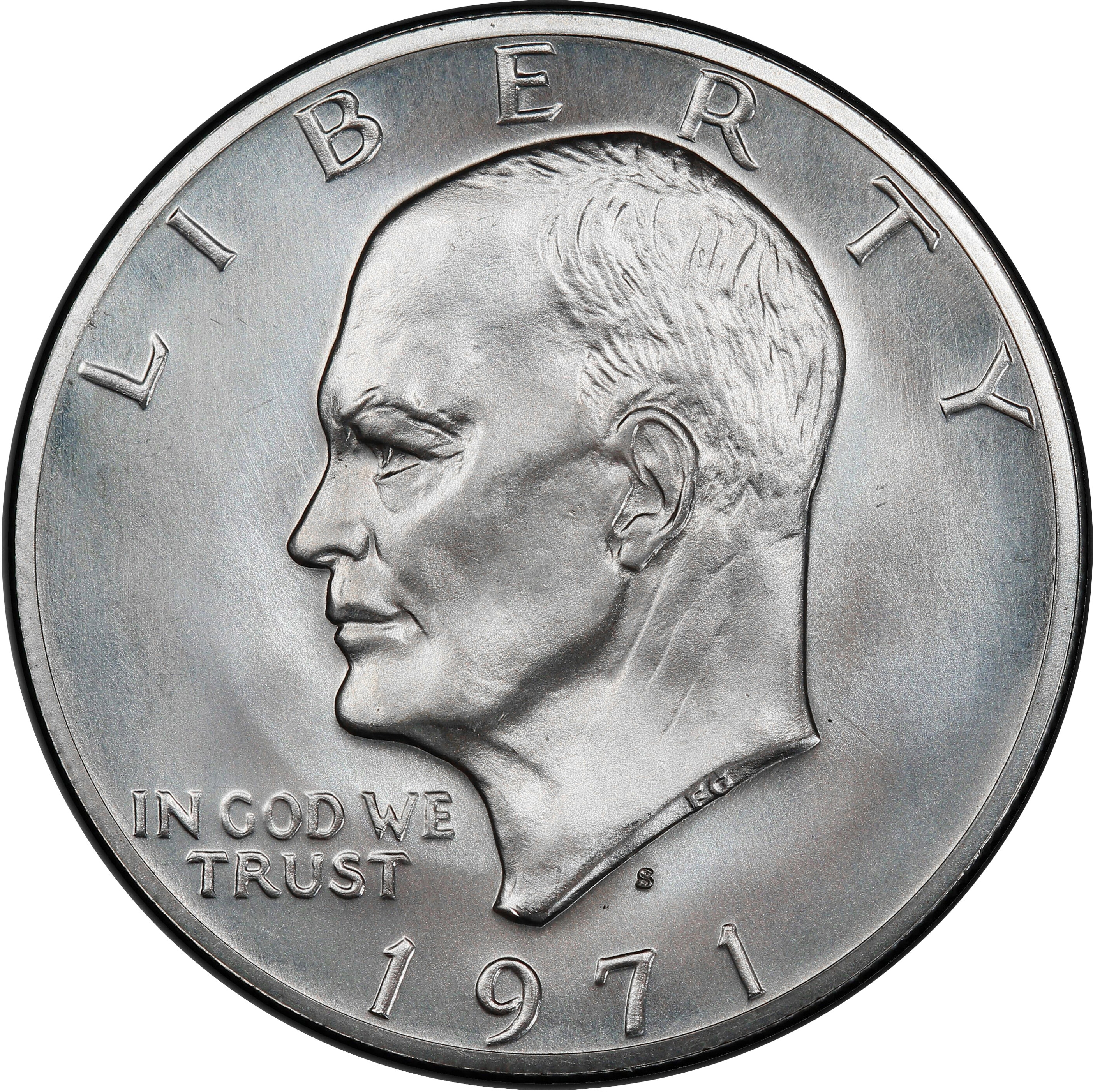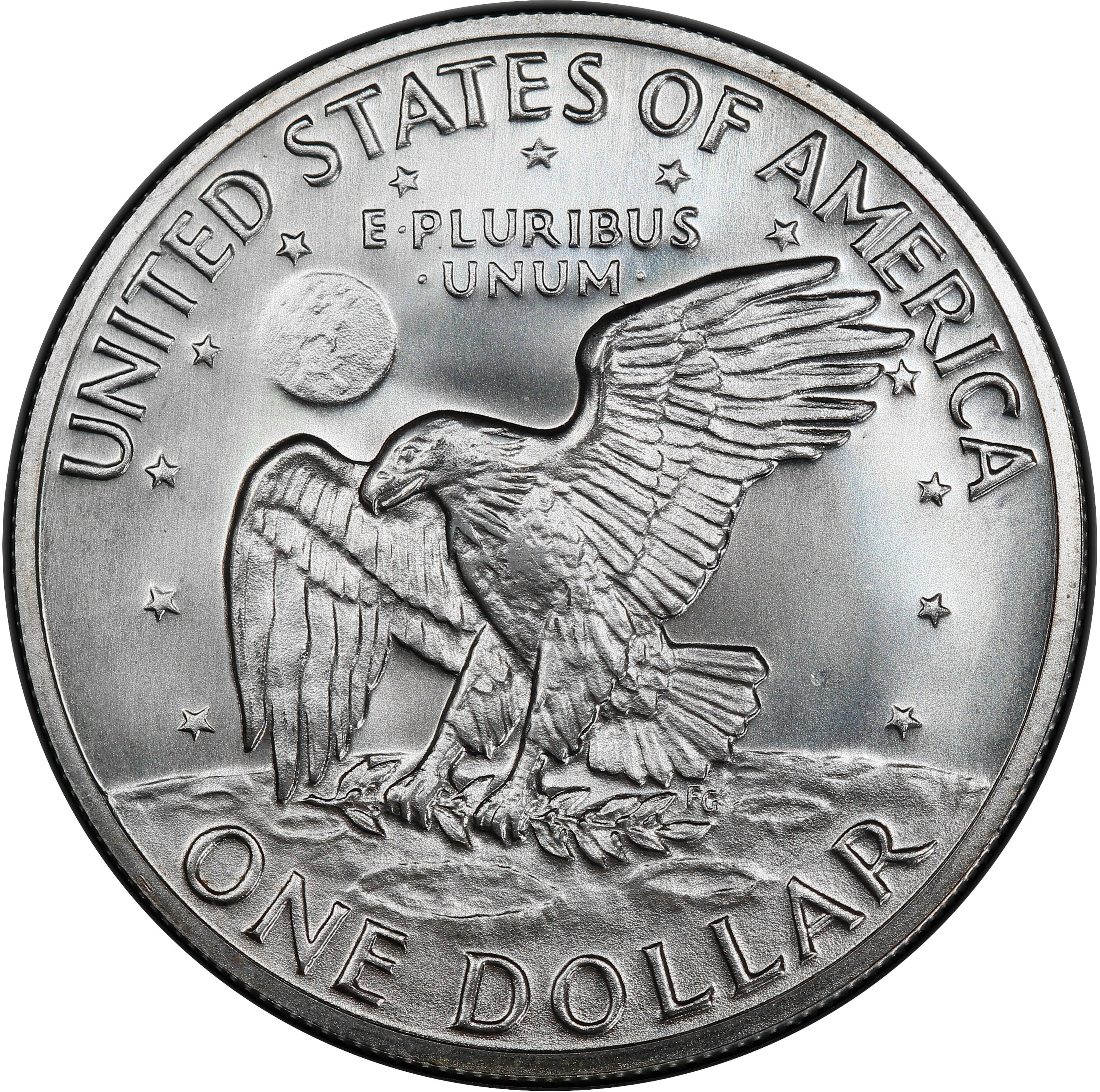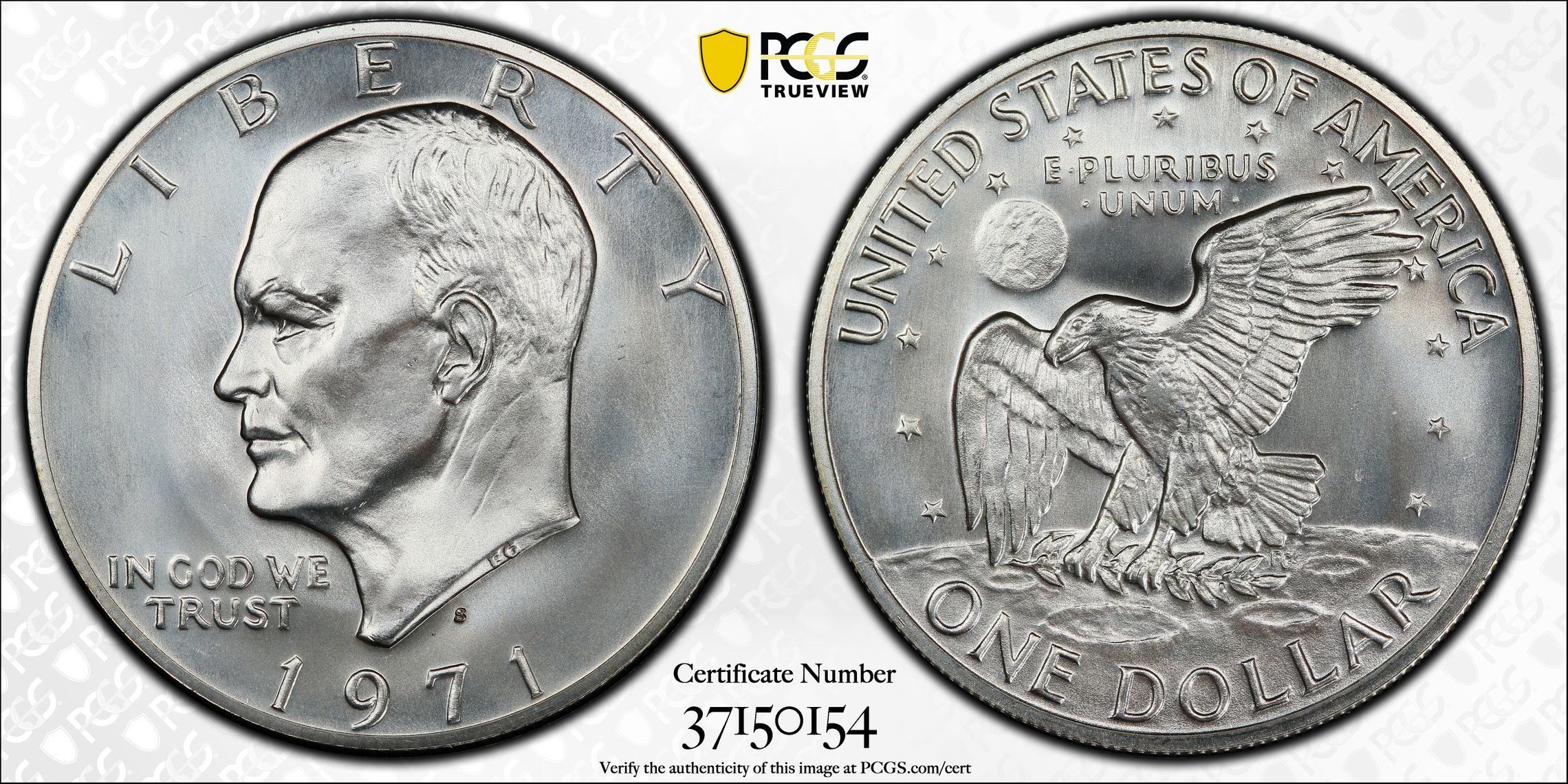Images Courtesy of Heritage Auctions, HA.com
1971-S Eisenhower Dollar Prototype, SP67
One of Three Known Working Prototypes
The Discovery Coin
First Auction Appearance of This Landmark Rarity
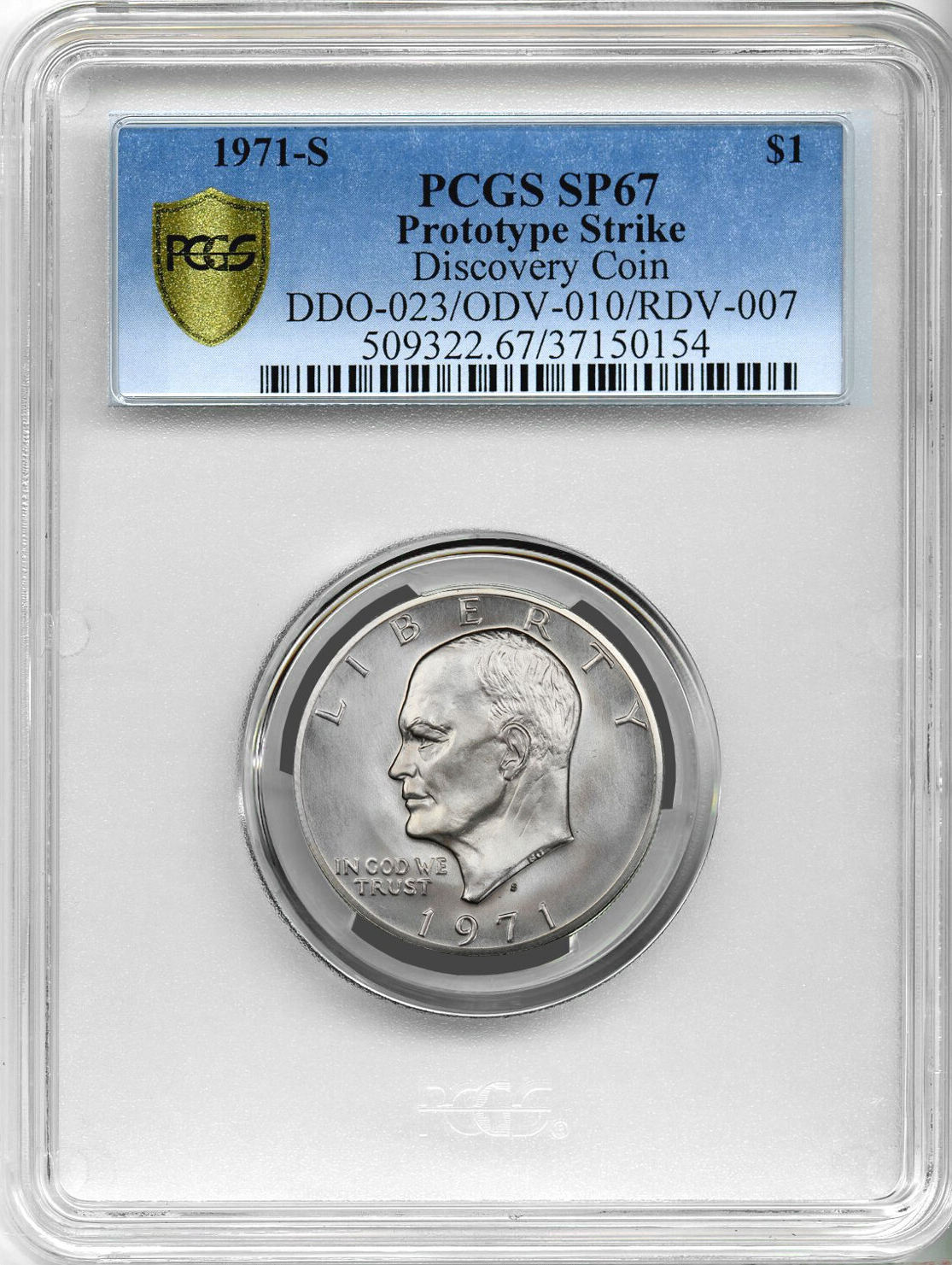

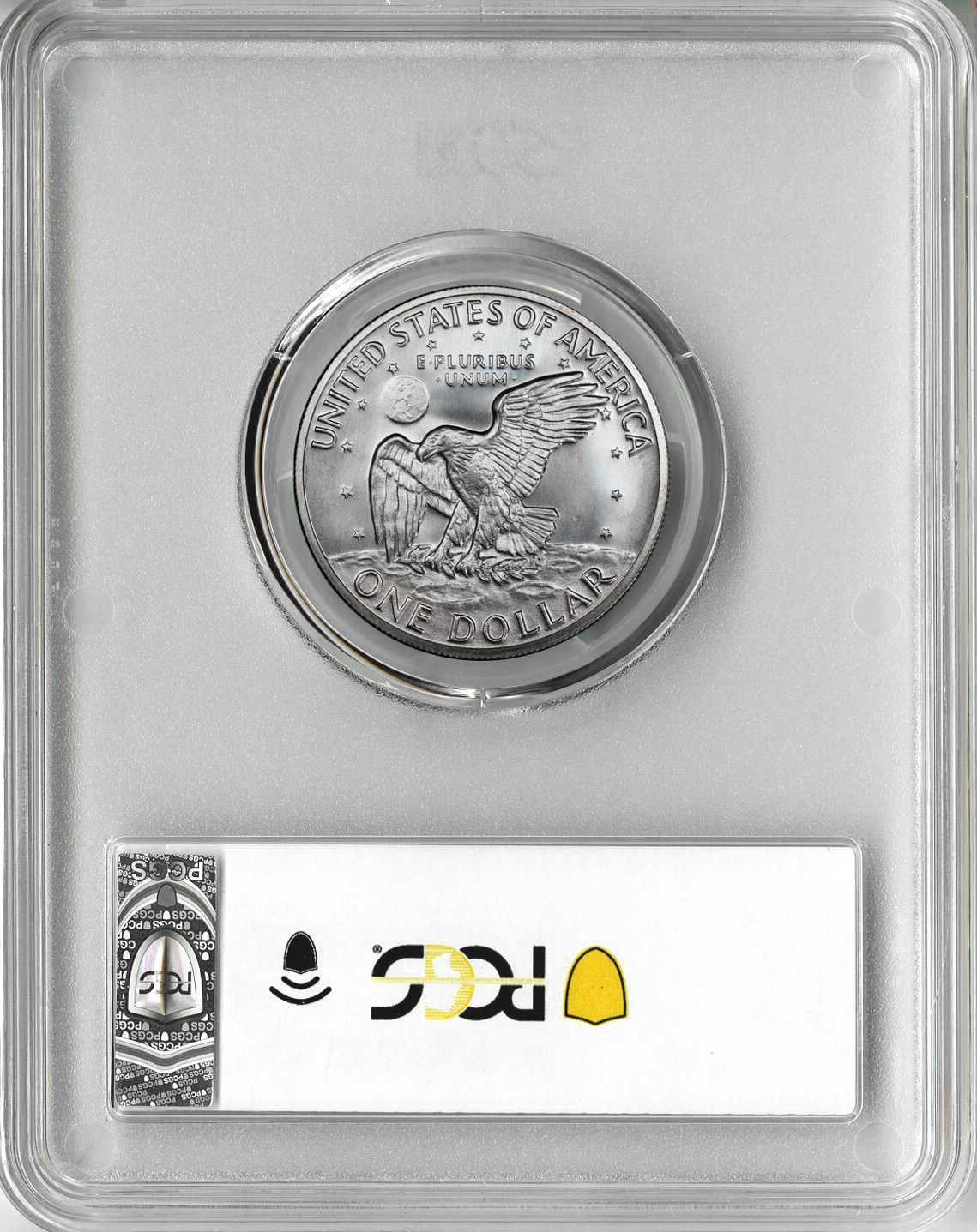
1971-S $1 Eisenhower Dollar Prototype, Specimen 67 PCGS. R.8. This prototype is one of the rarest of all silver dollars struck since 1794, and it has been poetically described as the "birth certificate of America's last silver dollar". Only three prototypes in total are known since being struck 50 years ago. Two of the three originate from this prototype's die pair, with a third struck from a different obverse prototype die. It is also one of the three earliest-known of all Eisenhower dollars, and bears a prototype design featuring an unfinished moon. This is the inaugural public sale of the "discovery" example of a U.S. Mint working prototype for a coin issued for circulation, and in its actual precious metal of issue. This is likely a historic numismatic first since the establishment of the United States Mint in 1792.
The three known prototypes are lacking from the Smithsonian's National Numismatic Collection, the United States Mint collection, all of the Federal Reserve museum collections, and the collections of the American Numismatic Association and American Numismatic Society. We would not be surprised if the new owner has the opportunity to place this coin on loan to any of these worthy institutions, among many others, and hope that he or she would accept such an invitation.
As there have been no public offerings of any of the prototypes, meaningful comparables are elusive. However, we view the 1975 No S proof dime, which sold for $456,000 in a Heritage auction in 2019, as a coin of similar rarity and mysterious origin. Similarly, the unique 1976 Eisenhower dollar No S proof appears in the PCGS Price Guide valued at $850,000.00. Numismatic history may well be made in Orlando this evening.
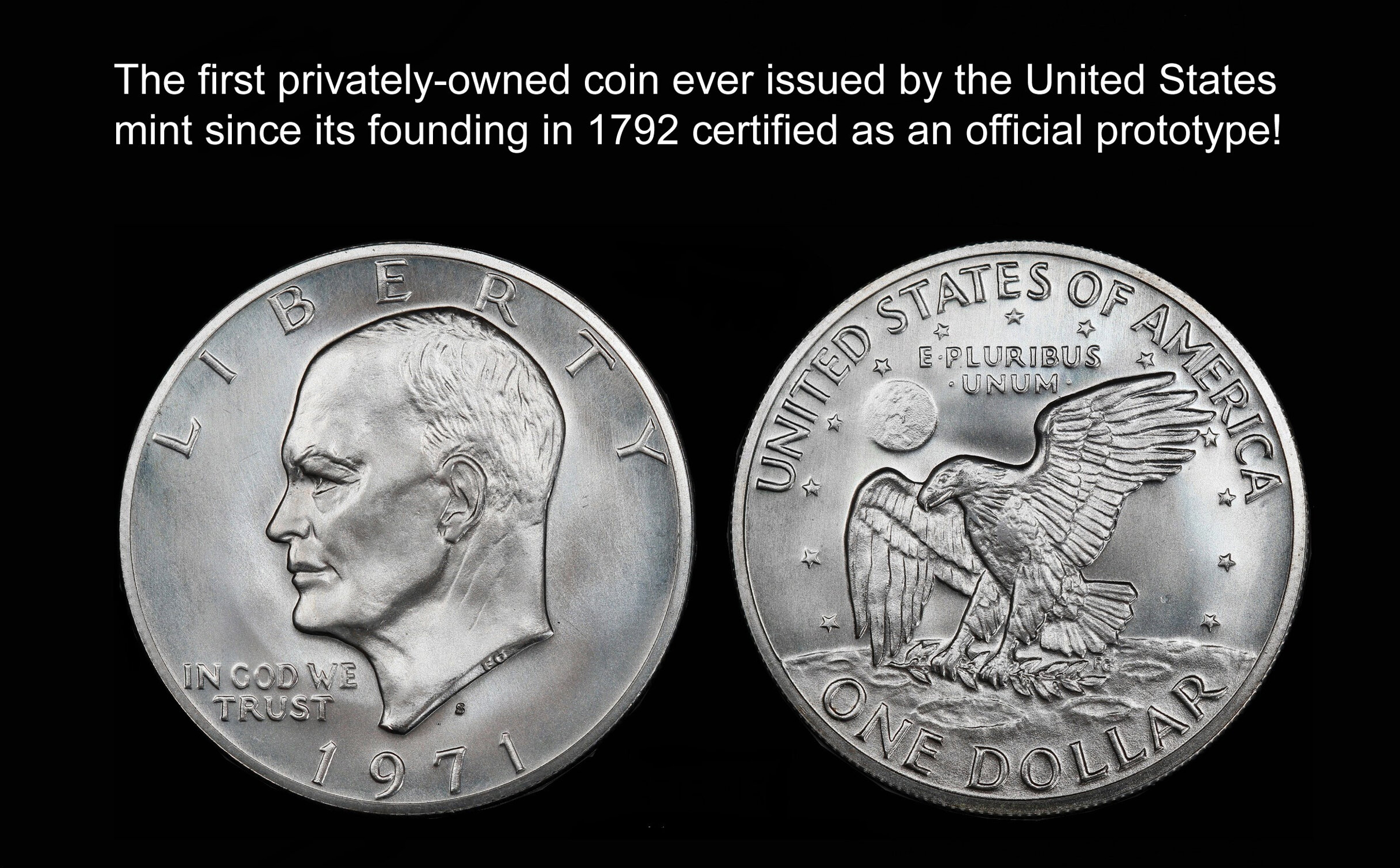
Pattern vs. Prototype
For centuries, no working prototype of any American coin destined for circulation in its actual metal of issue was known in private hands. That all changed when the three Eisenhower dollar prototypes first appeared via this discovery coin in 2008, followed by the second in 2010, and a final example in 2013. Unfortunately, the terms "pattern" and "prototype" are often used interchangeably and inappropriately. What, then, is a "pattern" coin, and how does it differ from a "prototype"?
A pattern coin is generally thought to be a concept coin, struck to evaluate a purely conceptual design never officially approved for circulation. Likewise, many pattern coins were struck in unrelated metals to that of any approved and issued coin series. Often they are nothing more than fantasy pieces, deliberately struck for sale or trade to collectors by mint officials. A vast number of pattern coins remain in collector hands, and many were actually traded by the Mint to collectors in exchange for items that it wanted. A famous example of this would be the fabulous 1877 Half Union gold patterns, traded by William Woodin to the Mint for, ironically, vast quantities of pattern coins. Pattern coins are specifically identified as patterns by their Judd catalog numbers, drawn from the Judd pattern reference. An excellent website we often recommend for studying pattern coins is uspatterns.com.
Prototypes, by contrast, are coins produced within the Mint for the chief engraver's actual day-to-day working use (hence, our term "working prototype"). They are a tool to perfect an officially approved coin design for circulation. There is nothing fanciful with a prototype as with most patterns; rather, prototypes are among the tools required to evolve a circulating coin from inception to production. One would also expect a true working prototype to be struck in its proper metal of issue. As, in turn, are the three known 1971-S Eisenhower dollar prototypes on their 40% silver planchets.
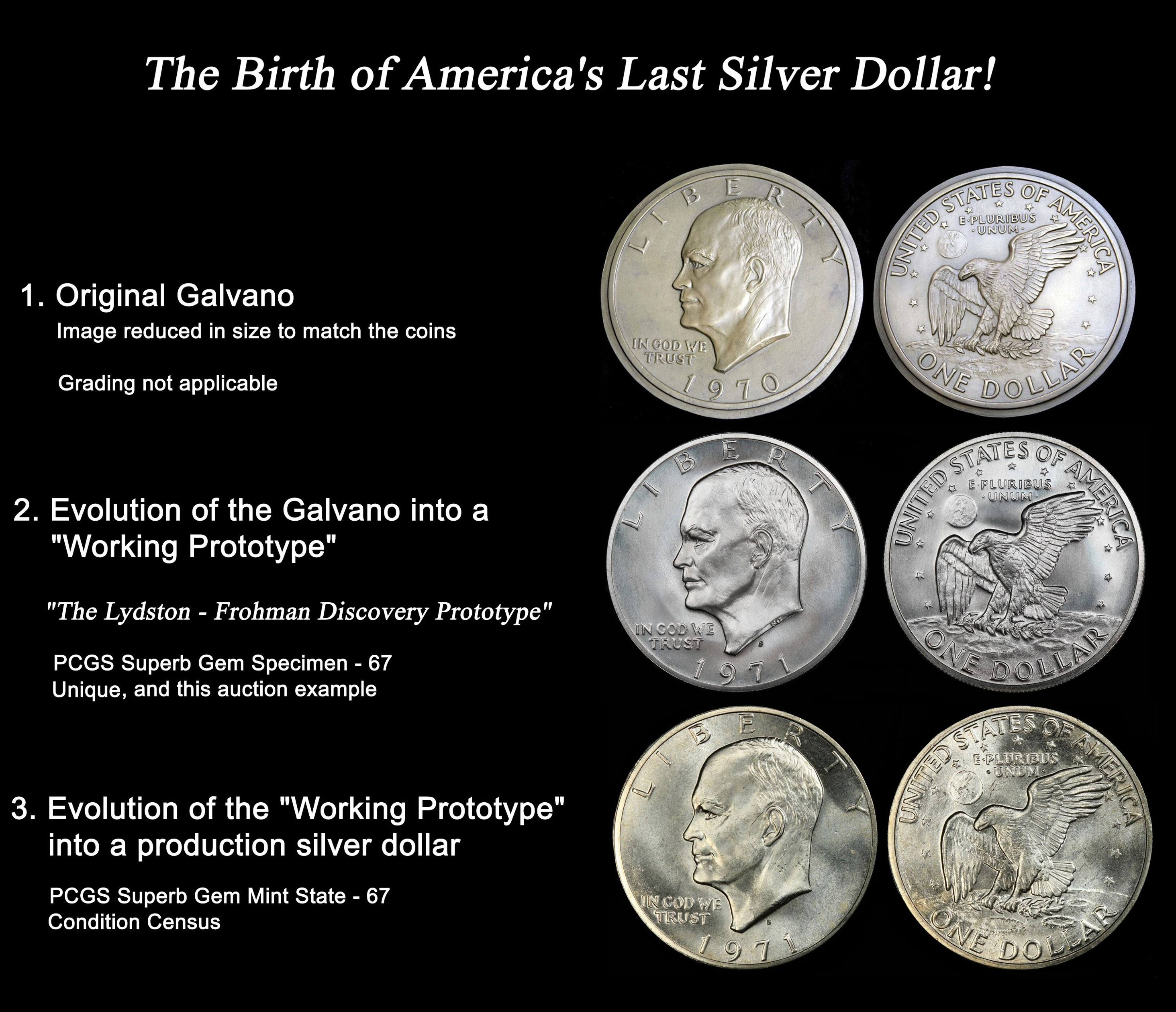
Likewise, they lack Judd pattern numbers as they are appropriately recognized by PCGS and others as true mint prototypes, and not patterns. Experts have even suggested that they were created to help determine the correct striking pressure for the first production coins struck on full-sized dollar planchets since 1935. At least two of the three prototypes may even have small handmade indentations on their reverse sides, possibly done to test the planchet's "hardness" after striking.
As prototypes, they bear an exclusive numismatic classification. However, we believe they would also have exceptional complementary series interest to pattern collectors, too. They have much in common with traditional patterns, and we believe would nicely complement that venerable series. After the auction, Heritage will thus nominate these coins for inclusion in the Judd pattern reference as pieces from a complementary series. And, also, for a new "Red Book" listing to record their official prototype status. If issued a Judd number, these will be the only three coins in existence with both official U.S. mint prototype status and a Judd catalog number. They are truly unsurpassed as being among the rarest and most fascinating coins in American numismatics.
Lee C. Lydston Discovers the First Prototype
On February 15, 2008, Eisenhower dollar expert collector Lee C. Lydston and his wife attended the "Long Beach" coin show. While there, Lee's wife called his attention to a dealer's table with tubes of Eisenhower dollars, of which one particular tube was found by Lee to contain a single 40% silver 1971-S Eisenhower dollar bearing an unusual appearance. Remarkably, it had hybrid characteristics of both the silver uncirculated and the silver proof Eisenhower dollars sold to collectors by the United States mint in 1971. The coin also exhibited the usual surface hazing imparted to Blue Pack uncirculated silver Eisenhower dollars, due to their long-term exposure to the mint's pliofilm packaging. Lydston then chose to submit his discovery to the Eisenhower dollar experts at the respected Ike Group for their analysis.
The Ike Group was founded by noted Eisenhower dollar expert and researcher Rob Ezerman, and its evaluation included comparison of an original 1970 Galvano at the Eisenhower Museum. The Ike Group, in turn, was responsible for its discovery there.
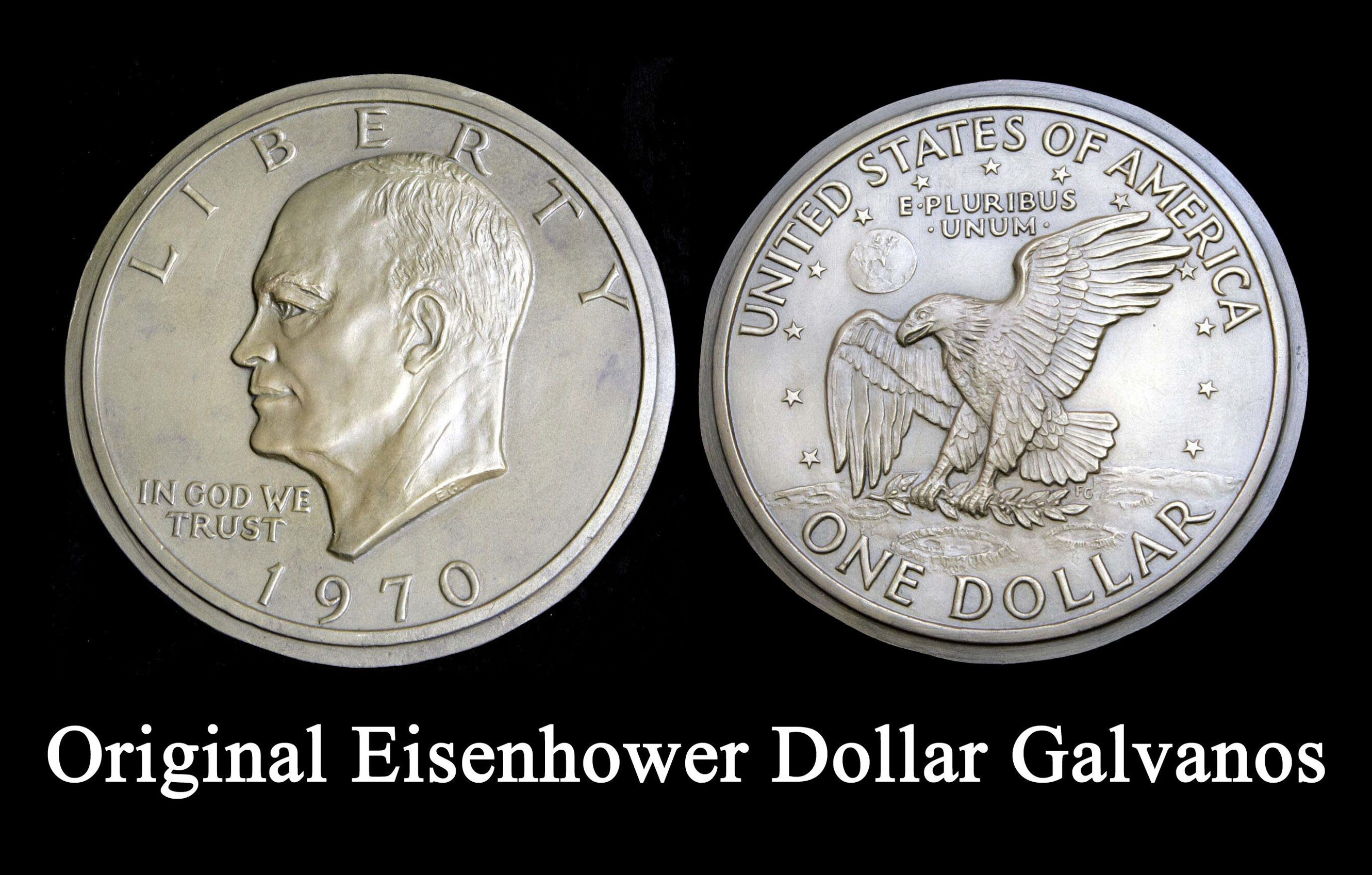
Rob Ezerman was the lead author of the first scholarly article about the prototypes in 2008. This was then followed by Ezerman's role once again as the lead author of the next major scholarly work on the prototypes, written after a second prototype appeared in 2010 (see both articles on the Ike Group's website here https://www.ikegroup.info/?page_id=203.)
Early Certification and Publicity
In 2008, the Lydston Prototype was examined by Dr. Wiles at CONECA, who determined the obverse and reverse dies were new design varieties. A condensed version of the Ike Group study was published as the cover story in CONECA's ErrorScope, Volume 17, May/June 2008 edition. The prototype was submitted to the American Numismatic Association Certification Service, where John Roberts, J.P. Martin, and Michael Fahey then confirmed the Ike Group's finding, and certified it as the first-known Eisenhower dollar Prototype. Then, on September 29, 2008, Coin World featured the prototype in a front-page article. This national publication announced the discovery of the prototype worldwide and furnished legal notice of its existence.
On September 8, 2011, Lee Lydston met with David Hall, founder of both the Professional Coin Grading Service (PCGS) and Collector's Universe, at the Long Beach coin convention for Mr. Hall to examine the ANACS certified prototype dollar. David Hall was so taken with the coin that he asked if he could personally submit it, on Lydston's behalf, for certification at PCGS. Accordingly, PCGS confirmed the present coin as a prototype, and certified it as SP65+.
More Discoveries
In later years, two more Eisenhower dollar prototypes were discovered, bringing the total to three. The second prototype was discovered in an Alabama pawn shop in 2010 by another Eisenhower dollar expert. It was also dated 1971-S and struck using the same reverse die as the Lydston prototype, but featured a unique obverse. It also had identical pliofilm hazing on its surfaces as the Lydston coin, but this time was reported to have been located still sealed within an official U.S. mint Blue Pack envelope. It was studied by the Ike Group, found to be a prototype, and later certified as such by PCGS circa 2019, after conservation. A third prototype, which featured the same obverse and reverse as the present coin, was purchased on eBay in 2013. PCGS then certified it as the third prototype, and graded it Specimen-66. The eBay seller confirmed to the buyer that it was originally housed within a sealed U.S. mint Blue Pack pliofilm package. It is sobering to consider that only three prototypes have been discovered in the half century since they were struck in 1971. This is far different from most newly discovered issues, where growing collector awareness tends to result in many more appearances over time.
The Prototype Becomes a PCGS Celebrity
In March of 2019, David Frohman purchased and submitted the present prototype to PCGS for analysis, conservation, and grading. When purchased by Frohman, the coin was still housed in its original 2011 PCGS prototype holder and graded SP65+. It also had a layer of pliofilm haze from its long-term exposure in its original Mint packaging. Frohman felt strongly that the haze should be removed, both to protect the coin long-term and to unveil its extraordinary beauty. He also felt that once the coin was conserved by PCGS and regraded, it would receive a substantially higher grade. The following excerpt is from the PCGS CoinFacts article written by Joshua McMorrow Hernandez in 2020:
"When the two Ike prototypes crossed the desks at PCGS, they turned plenty of heads. 'I remember the day vividly that Joe Pielago, one of our business development managers, told me we were getting a prototype Ike in for grading,' recalls PCGS Director of Numismatic Education and Outreach Steve Feltner. 'First of all, I had never heard of anything like that before and was very excited to see it. Upon initial inspection, there was no denying that the coin was special' he says.
"Feltner noted the Ikes have a bolder strike than the typical 40% silver Blue Ikes that are commonly seen. 'I remember the first place my eye gravitated to was the Moon on the reverse. It was an unforgettable experience being able to hold this piece of history and see what Gasparro's vision was for his dollar,' Feltner adds. 'Then having a second example come through the grading room was the cherry on top!' Both coins were processed through various stages of authentication and research at PCGS, including metallurgical testing to determine the weight and metallic composition of the planchets.
"'Using our in-house x-ray fluorescence analyzer to check the elemental composition of the planchets - and using a standard 1971-S Blue Pack Ike as a test coin - the two prototype coins were found to be within a close tolerance of the standard,' explains Feltner, who reported that the compositional material of the outer silver-clad layer of the coins were within normal tolerances of the copper-silver alloy and showed no real deviation from the standard test coin. The coins were also expertly conserved by the PCGS Restoration team to remove their pliofilm-related haze before being sonically sealed in their protective slabs."
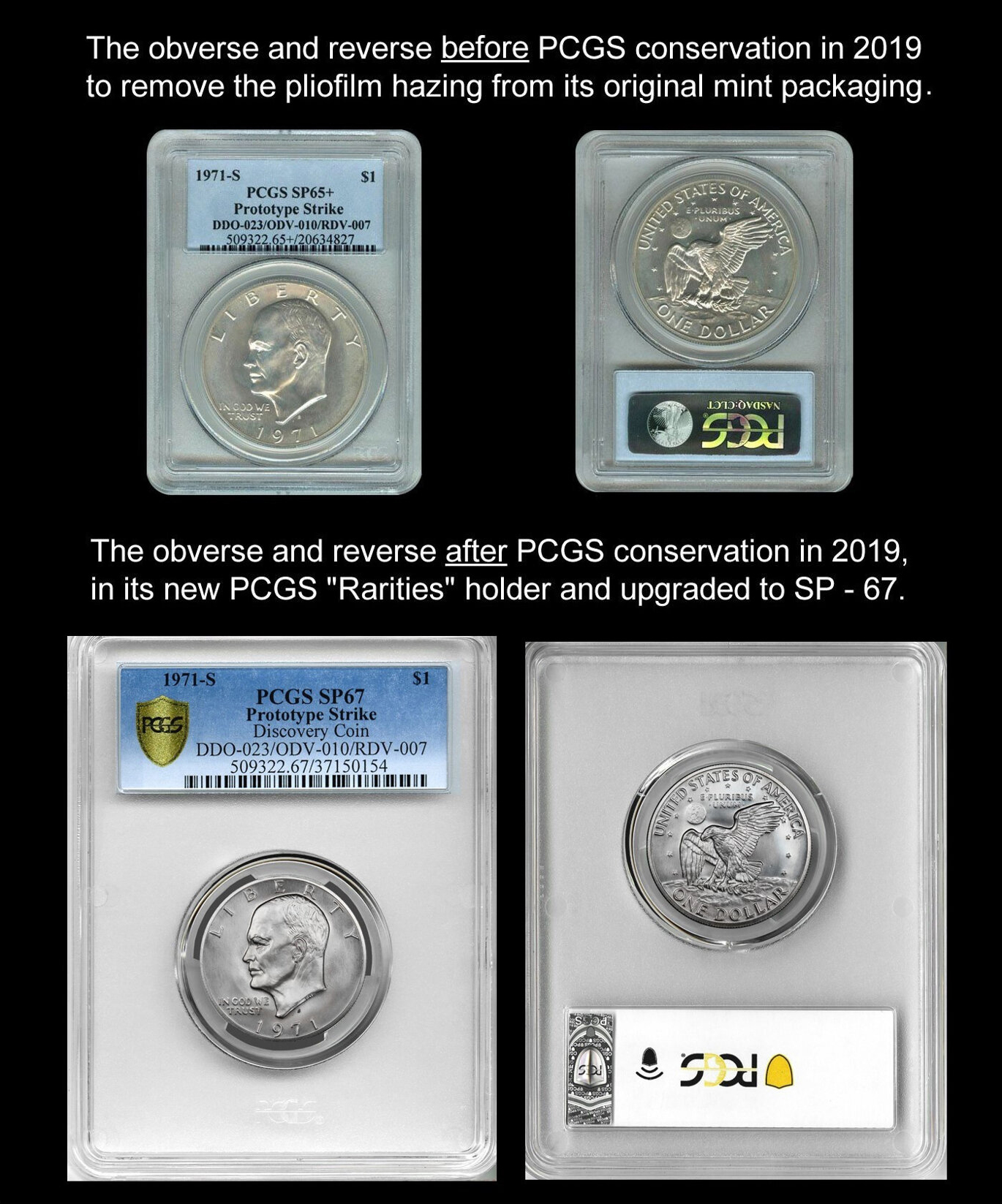
After conservation, the Lydston-Frohman prototype was housed in a PCGS Rarities holder, and upgraded to Specimen 67. This coin is currently pictured on PCGS CoinFacts, accompanied by the article by Joshua McMorrow Hernandez which may be viewed here:
https://www.pcgs.com/news/two-unique-prototype-eisenhower-dollars-certified-by-pcgs
Origin Theories for the Prototypes
Prominent researcher Roger W. Burdette notes that research on the origin of these prototypes is incomplete, as the National Archives facility in Maryland is temporarily closed. However, we offer two plausible theories to explain their release to the public by the mint in its official mint packaging.
1) The Philadelphia Mint Theory
On January 19, 1971, the U.S. Mint issued a press release announcing that:
"For the first time in its history, the U.S. Mint is permitting the news media to witness the trial strike of a coin as well as the designing and engraving process. On Monday, January 25, 1971, at 11:00 AM, the first trial strikes of the new dollar coin bearing the likeness of former President Dwight D. Eisenhower will be made at the U.S. Mint in Philadelphia, Pennsylvania.
"The Eisenhower dollar coin, provided for in the 1970 Coinage Law, is the first dollar coin to be produced since 1935. Because of the great public interest in its issuance, the Director of the Mint, Mary T. Brooks, is inviting the news media to see the preliminary production process."
Another press release, dated January 25, 1971, confirmed that Eisenhower dollar prototypes were struck in 40% silver that day. However, the document noted they "must be and will be destroyed by the Director's Committee." This prototype and its two companions may possibly be from those experimental pieces, if they somehow escaped destruction. David Frohman suggests that if they are specifically from among those ten, then they may have been sent to the San Francisco Assay Office for in-person study, after being requested by its superintendent upon seeing that press release.
Given the fact that no regular-issue silver dollars had been struck since the Peace dollar was discontinued in 1935, and the special Eisenhower dollars for collectors were to be struck on unfamiliar silver-clad planchets, this is a reasonable suggestion. It may be that the "study coins" were later mistakenly shipped to the New York Assay Office with regular 40% silver uncirculated specimens, then officially packaged in error and legally sold in the mint's Blue Packs. This theory would explain how the prototypes were acquired by collectors in a perfectly legal fashion, through official channels at the Mint. This is in stark contrast to, for example, a 1974 aluminum cent loaned to a congressman and never returned. Or a pressman clandestinely keeping a 1964-D Peace dollar. Or a Mint employee secretly manufacturing error coins and smuggling them out of the Mint, hoping to make a quick profit. Rather, the prototypes only began randomly appearing across the country 37 years after their creation, with each subsequently purchased for only a few dollars. If there had been any nefarious intent in 1971, it would not have taken nearly forty years for the coins to appear on the market. Much less with one example (this coin) found discarded in a roll of junk 40% silver Eisenhower dollars, and bought by Lee Lydston in 2008 for $10.00 in California. And a second bought in a pawn shop in Alabama in 2010 in its original Mint packaging for $5.00. And a third bought in 2013 on eBay for $22.00.
Based upon the circumstances of their discoveries in official Mint packaging, they are legal to own, and their inexpensive purchase price upon surfacing decades later confirms no illegal intent. They were also properly publicized (and appropriate legal notice furnished) first in 2008 by Coin World in a front page featured article, and again twelve years later in 2020 via the PCGS article with worldwide reach. Working prototypes like these coins would normally be destroyed by Director's Committee as soon as they served their purpose. However, a remarkable series of fortunate circumstances appear to have preserved these historic specimens, and made them legally available to eager collectors.
2) The San Francisco Mint Theory: Extremely Rare Branch Mint Prototypes
Another theory postulates the prototypes were struck at the San Francisco Mint, and from prototype dies shipped from the Philadelphia Mint for trial strikes. This theory accounts for the fact that the prototypes all display an S mintmark. The mintmark was not part of the design process, and not normally included on prototype dies. In fact, the mintmark was typically the last element punched into the working die before it was shipped to a branch mint. No documents about striking prototypes at the San Francisco Mint in 1971 are known, but we know trial dies were sent to the San Francisco Assay Office in 1975. At that time, the Mint was finalizing the design for the Bicentennial issues. A June 5, 1975 dated letter from Alan J. Goldman, Assistant Director of Technology at Philadelphia, to Mr. Bland T. Brockenborough, Officer in Charge of the San Francisco Assay Office, notes:
"Two trial versions of the improved bicentennial dollar design have been successfully struck at the Philadelphia Mint. We do not have the chrome plating arrangements nor the HME press capacity there to try out proof production runs. In addition, I believe it would be worthwhile testing the new dies under actual proof production conditions in your facility. The Philadelphia Mint has shipped the dies to the San Francisco Assay Office for trial striking. Please arrange for proper security of the dies to insure that no coins are made from them except under the direct supervision of a committee composed of William Smith of my staff, your representative, and an auditor. A strict accounting of blanks delivered to the press, coins struck, coins destroyed, coins retained, and disposition of coins retained is required for each alloy."
Of course, the trial striking of Bicentennial coinage in 1975 is not the same as prototype strikes for the Eisenhower dollar in 1971 but, as Roger Burdette notes, "It is likely that similar experimentation was required." If the Philadelphia Mint did not have the chrome plating apparatus for the dies or the Bliss K255 hydraulic press used to strike proofs in 1975, they certainly would not have had that equipment in 1971, since all proofs had been struck at the San Francisco facility since 1968.
Under this scenario, the trial pieces struck in Philadelphia on January 25, 1971 were destroyed by the Director's Committee, as per Mint policy. Later, prototype dies were sent to the San Francisco Mint for trial striking on the proof machinery that was not available in Philadelphia. If the coins were struck from chrome-plated dies intended for proof production, on unpolished 40% silver planchets, that might account for the hybrid proof / business strike appearance of their surfaces. Also, we know that proofs were struck twice by the coin press, while the uncirculated specimens were only struck once. If the prototypes were only struck once as trial pieces for the uncirculated collector coins, it explains why some high relief design elements like the earth on the reverse were not completely brought up. While a strict accounting of the trial strikes was demanded, it is worth noting that their destruction was not explicitly required. It seems entirely possible, even likely, that the trial strikes were considered so close to the final design as to be indistinguishable from regular issues by the general public, or even Mint employees. Indeed, chief engraver Frank Gasparro was under great pressure to get "anything and everything" out of the door, as they were so far behind. The prototypes then went unnoticed for 37 years before a series specialist discovered one. Under these circumstances, it might be possible for the prototypes to be treated as regular issues, and shipped to the New York Assay Office for sale in "Blue Packs". Hopefully, further research in the National Archives, once it reopens, will shed more light on the origin of these mysterious prototypes.
The Eisenhower Dollar
On October 25, 1969, Congressman Bob Casey of Texas proposed a bill to authorize a dollar coin. That would commemorate the landing of Apollo XI on the moon in July of 1969, and the passing of President Dwight David Eisenhower four months earlier. No special legislation was required to change the design of the dollar, since it had been more than 25 years since the last design change for the denomination. The Peace Dollar had been introduced in 1921.
Eisenhower was a personal hero of Chief Engraver Frank Gasparro, who designed the obverse portrait of the new dollar from his 1945 sketch. The reverse was inspired by the Apollo XI crew mission patch, originally designed by astronaut Michael Collins. It depicted a "peaceful" eagle with an olive branch landing on the moon. Gasparro started work on the dies over Thanksgiving weekend in 1970 and President Richard Nixon signed the "Bank Holding Act" on December 31st which provided for the striking of the coins.
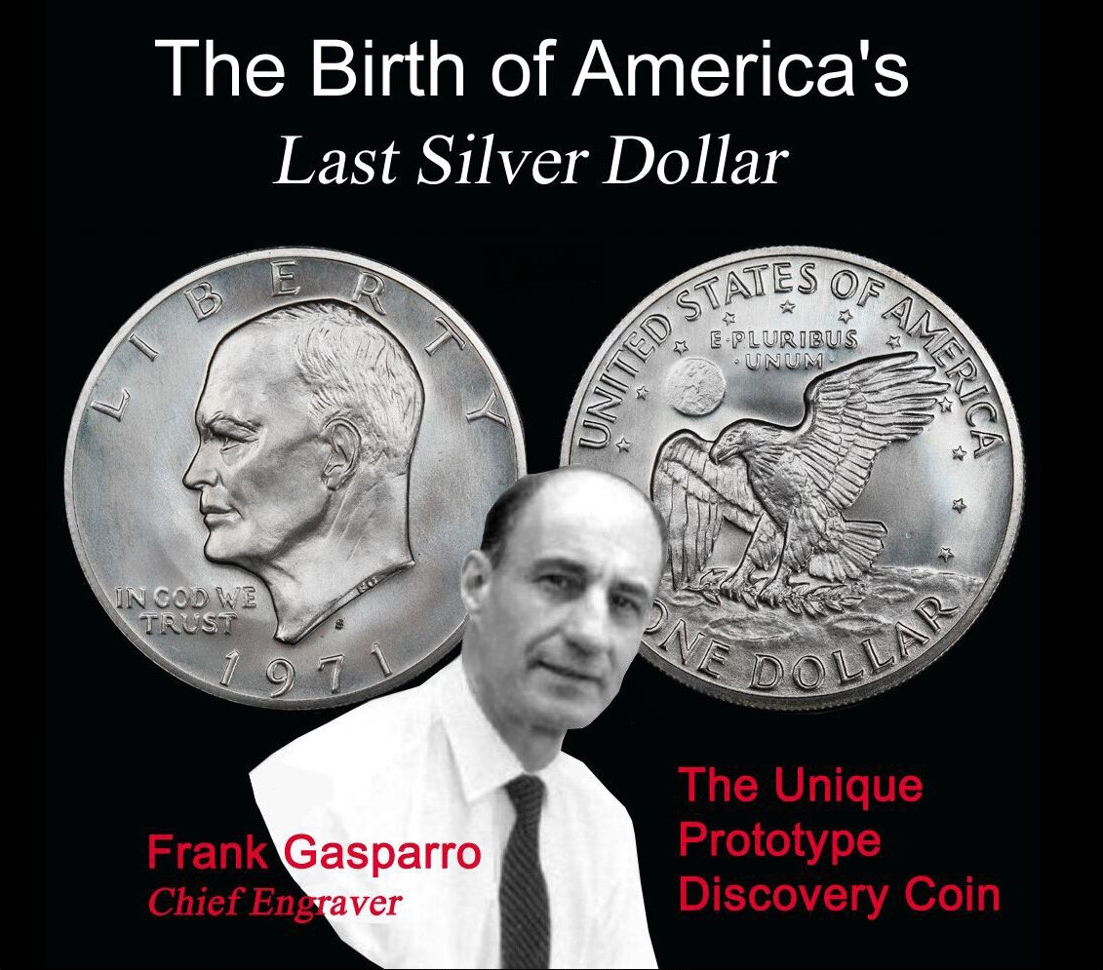
Business-strike Eisenhower dollars were struck on copper-nickel clad planchets beginning in 1971. The original intention was to produce three mintages of special coins for collectors to accompany the regular-issue copper-nickel coinage: a 40% silver clad mintage in proof format, a 40% silver clad striking in uncirculated condition, and a copper-nickel clad proof mintage. In the end, the copper-nickel proofs were deemed impractical, and only the two 40% silver issues were actually struck. Business-strike Eisenhower dollars were struck at the Philadelphia and Denver Mints, while the 40% silver special issues were struck in San Francisco. The silver-clad uncirculated coins were struck in San Francisco, and shipped in bags to the New York Assay Office for packaging and mailing. They were distributed in Blue Packs, which were pliofilm packages placed in blue envelopes, and sold for $3.00. They were released for sale, with "First Strike" ceremonies held in San Francisco on March 31, 1971. The silver clad proofs were not included in the proof sets, but were placed in plastic containers inside a brown, wood-grained box, and sold individually for a price of $10.00. Order blanks were made available to the public on June 18th, and orders limited to five proof and five uncirculated coins per person.
Physical Description
This surreal prototype survived essentially as struck, and is now housed in a PCGS "Rarities" holder graded SP-67 and labeled "Discovery Coin". It has a stunningly beautiful and almost medallic high relief appearance, with some doubling evident on the motto and date. The letters in LIBERTY have lighter serifs than the lettering on the 1971-S 40% silver proofs. The design elements are sharply detailed in most areas, with just a touch of softness evident on the moon and eagle's breast due to the design's high relief. The rims are perfect and square and the devices richly frosted. The reeding is identical to that on the low relief 40% silver Ike dollars in the Blue Packs. Strong prooflike reflectivity is evident in the fields, and many die polishing lines show on both sides. The virtually flawless surfaces add to the terrific eye appeal. A small depression near the eagle's tail may be the result of mint personnel testing the planchet hardness. Significantly, a similar mark shows in nearly the same spot on another prototype.
This magnificent superb gem is the discovery coin for the extremely rare Eisenhower dollar prototype. It is one of only three examples discovered in the half-century since their creation, the unique "discovery coin", and one of only three pieces available to collectors. It combines the highest available technical quality, profound historic interest, and absolute rarity in one irresistible package. It may be decades before it returns to the market if placed on long-term institutional loan, and discerning parties will want to bid accordingly. This coin is pictured in PCGS CoinFacts. Population: 1 in SP67, 0 finer (10/21).
Heritage Auctions would like to acknowledge and thank Rob Ezerman, founder of the "Ike Group", for his expertise in reviewing this catalog description. Mr. Ezerman's formal review of this lot description is available upon request.
Coin Index Numbers: (PCGS# 509322)
Weight: 24.59 grams
Metal: 60% Copper, 40% Silver


